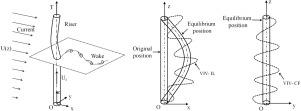变张力输液立管的直列和横流涡激耦合振动响应
IF 4.4
2区 工程技术
Q1 ENGINEERING, OCEAN
引用次数: 0
摘要
当海水在立管周围流动时,会产生涡激振动(VIV),这种振动有两种形式:直线振动(IL)和交叉振动(CF),并且这两种形式相互影响。准确的预测耦合的IL和CF的VIV行为对提升管的设计至关重要。为此,建立了考虑内流的变张力耦合涡激振动模型,分析了垂直立管在线性剪切流中的耦合涡激振动特性。立管被建模为欧拉-伯努利梁,使用两个范德波尔尾迹振荡器模拟阻力和升力系数,在IL和CF方向上的运动方程与流体力耦合。利用广义积分变换技术将耦合的非线性偏微分方程转化为一组非线性常微分方程进行数值求解。首先将数值结果与已有参考数据进行对比,验证了模型的有效性,然后分析了IL和CF耦合模型与单向CF仅VIV模型的差异。分析了均匀流动、线性剪切流动和三种不同张力模式对耦合涡激振动的影响。最后,对内外流速对立管耦合涡激振动的影响进行了参数化分析。研究结果表明,与CF方向相比,IL方向的振动响应更为复杂。与均匀流动相比,剪切流动主要影响IL方向的振动,变张力影响IL方向的平均位移峰值位置以及IL和CF方向的振动模式。外流速度影响IL方向的入能区,内流速度影响CF方向的入能区。随着内部流速的增大,行波的特性变得更加明显。研究发现,适当的内流速可以稳定立管涡激振动。本文章由计算机程序翻译,如有差异,请以英文原文为准。

Coupled in-line and cross-flow vortex-induced vibration responses of a fluid-conveying riser with a variable tension
When seawater flows around a riser, it induces vortex-induced vibrations (VIV), which occur in two forms: in-line (IL) and cross-flow (CF), and these two forms influence each other. Accurate prediction of the coupled IL and CF VIV behavior is crucial for riser design. Therefore, a coupled VIV model with variable tension considering internal flow was established to analyze the coupled VIV behavior of a vertical riser in a linear shear flow. The riser is modeled as an Euler–Bernoulli beam, using two van der Pol wake oscillators to simulate the drag and lift coefficients, with the equations of motion in the IL and CF directions coupled by fluid forces. The generalized integral transform technique (GITT) is used to transform the coupled nonlinear partial differential equations into a set of nonlinear ordinary differential equations for numerical solution. The model is first validated by comparing numerical results with existing reference data, and then the differences between the IL and CF coupled model and with one-direction CF only VIV model are analyzed. The effects of uniform flow, linear shear flow, and three different tension models on coupled VIV are analyzed. Finally, a parametric analysis of the impact of external and internal flow velocities on riser coupled VIV is conducted. The results show that the vibration response in the IL direction is more complex than in the CF direction. Compared to uniform flow, shear flow mainly affects the vibration in the IL direction, and variable tension impacts the mean displacement peak position in the IL direction as well as the vibration modes in both IL and CF directions. The external flow velocity affects the power-in region in the IL direction, while the internal flow velocity affects that in the CF direction. As the internal flow velocity increases, the characteristics of the traveling waves become more pronounced. The study finds that an appropriate internal flow velocity can stabilize the vibration of the VIV of the riser.
求助全文
通过发布文献求助,成功后即可免费获取论文全文。
去求助
来源期刊

Applied Ocean Research
地学-工程:大洋
CiteScore
8.70
自引率
7.00%
发文量
316
审稿时长
59 days
期刊介绍:
The aim of Applied Ocean Research is to encourage the submission of papers that advance the state of knowledge in a range of topics relevant to ocean engineering.
 求助内容:
求助内容: 应助结果提醒方式:
应助结果提醒方式:


